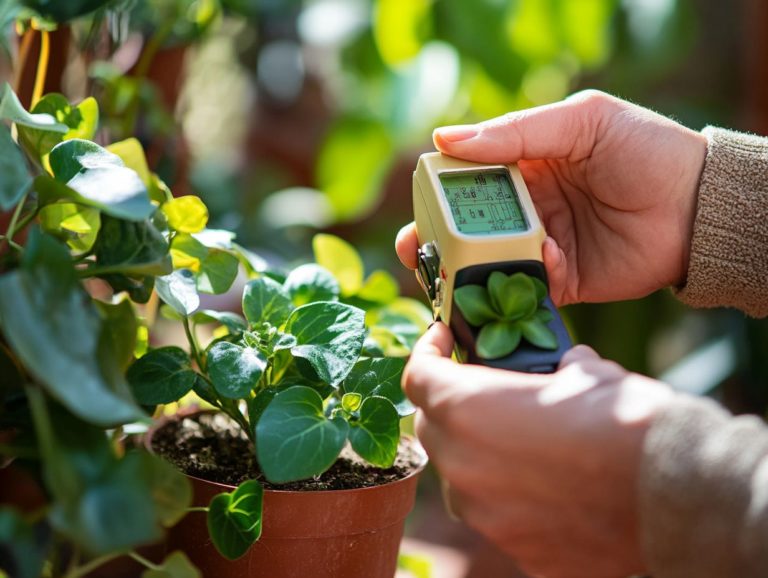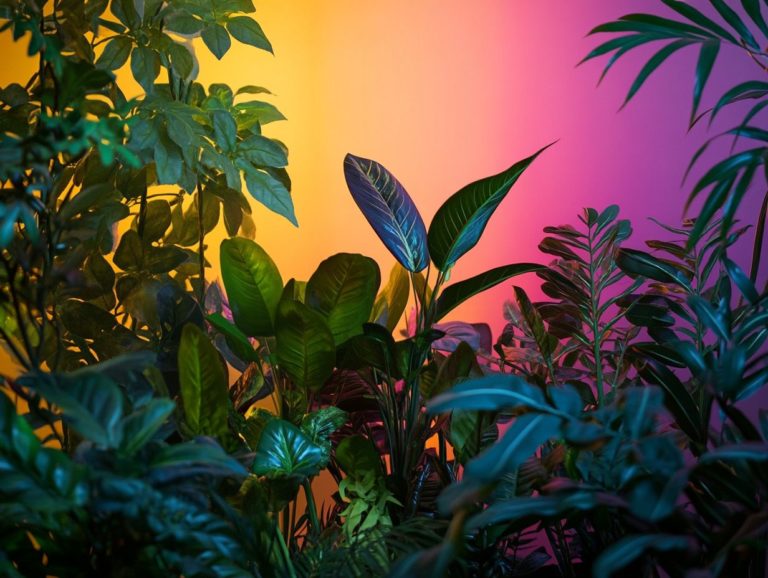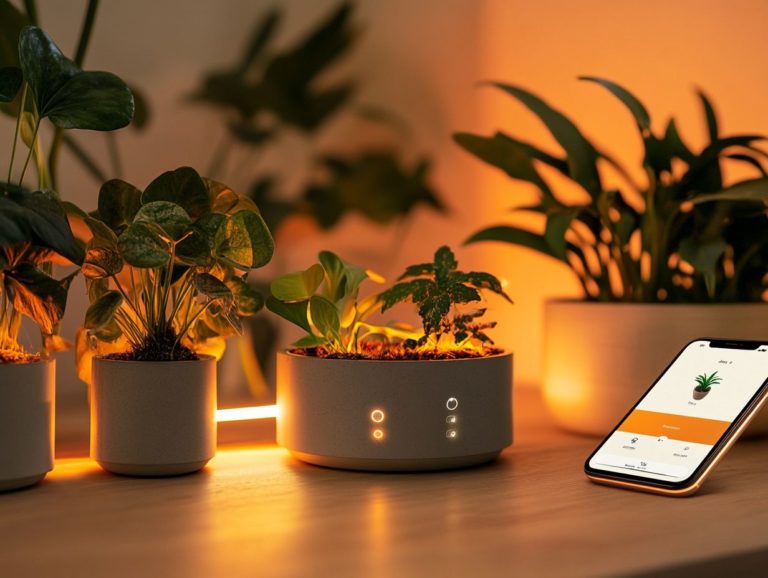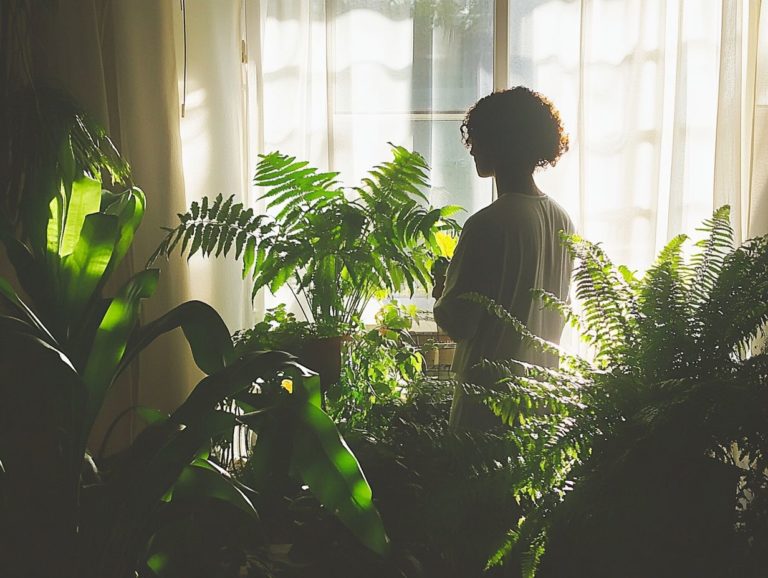Comparison of LED vs Fluorescent Grow Lights
Transform your indoor gardening experience by selecting the right grow lights. Get ready to discover how the right lighting can elevate your plants growth journey!
This article explores two popular options: LED and fluorescent grow lights. You ll find a comprehensive breakdown of what each type offers, highlighting their distinct benefits and unique features.
Whether you prefer the energy efficiency and longevity of LEDs or appreciate the lower initial cost and broader light spectrum of fluorescent grow lights, understanding these differences is crucial for making informed decisions about your indoor gardening setup.
Join us as we examine their pros and cons to guide you toward the ideal lighting solution for your cultivation needs.
Contents
Key Takeaways:
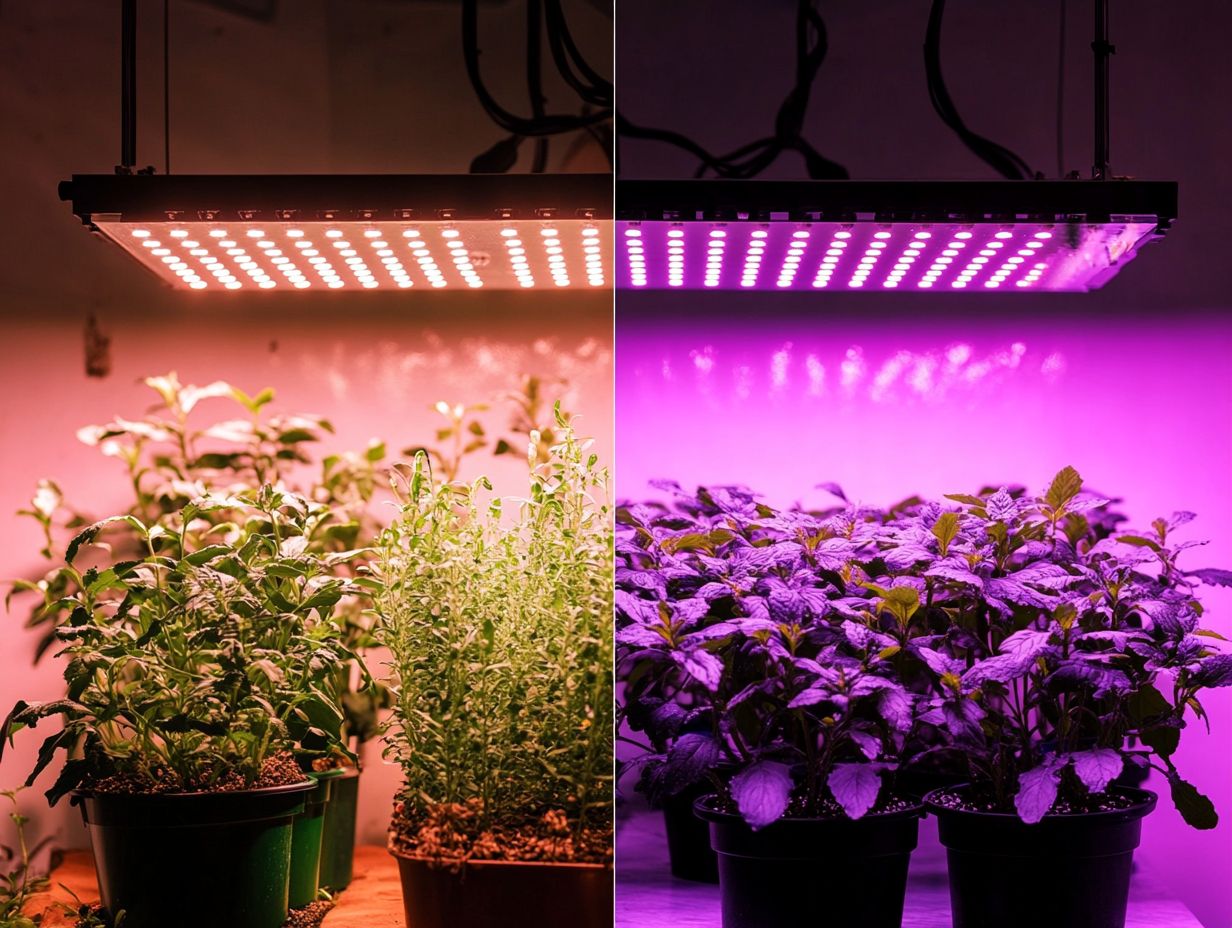
LED grow lights offer energy efficiency and cost savings compared to fluorescent grow lights.
Fluorescent grow lights have a lower upfront cost and a wider light spectrum but may not last as long as LED grow lights.
When choosing between LED and fluorescent grow lights, consider factors such as energy efficiency, cost, longevity, and light spectrum to determine which is the best fit for your needs.
Overview of LED and Fluorescent Grow Lights
In indoor gardening, understanding the differences between LED grow lights and fluorescent grow lights is essential for maximizing plant growth.
LED systems excel in energy efficiency and impressive lifespan, delivering tailored light spectrums that enhance photosynthesis for various plant types.
Compact fluorescent grow lights (CFLs) offer a budget-friendly alternative with a wider light spectrum, ideal for greenhouse applications. Choosing the right lighting technology significantly affects your operating costs and how well your plants grow.
What are LED and Fluorescent Grow Lights?
LED grow lights use small lights that produce specific colors of light for different plant types. In contrast, fluorescent grow lights, whether T5 or T8 variants, emit a broader spectrum of light, making them versatile for various horticultural applications.
Both technologies serve unique functions, making them excellent choices for indoor gardening and greenhouse environments. LED lights convert energy efficiently, allowing for precise spectrum emissions that dramatically enhance plant growth and flowering. Fluorescent lights provide more diffused light, covering larger areas and serving as a general lighting solution particularly beneficial for seedlings and low-light plants.
While LEDs might require a higher initial investment, they consume less energy over time. Fluorescent options are often more budget-friendly upfront but typically need more frequent replacements. Understanding these differences empowers you to choose the best lighting for thriving plants.
Benefits of LED Grow Lights
LED grow lights have taken the indoor gardening world by storm! Their energy efficiency and impressive longevity make them a sustainable choice for passionate hobbyists and dedicated professionals alike.
With lower maintenance costs and adjustable light intensity and spectrum, you can significantly enhance plant growth and optimize photosynthesis during critical growth stages, including the flowering stage.
Choose the best grow lights today to elevate your indoor gardening experience!
Energy Efficiency and Cost Savings
The energy efficiency of LED grow lights translates into significant cost savings for you as a grower. These lights consume far less electrical energy compared to traditional fluorescent lamps. This enables a more budget-friendly approach to your indoor gardening endeavors.
By drastically reducing energy consumption, you can save up to 75% on your electricity bills over time. For instance, if your grow operation currently spends $500 monthly on traditional lighting, those costs could drop to just $125 with LEDs. With these impressive savings, you can invest in other important areas, like nutrient supplies or improved ventilation!
Not only does this lowered energy demand benefit your finances, but it also diminishes the greenhouse gas emissions connected to electricity production. With every kilowatt-hour you save, your environmental footprint shrinks, promoting a more sustainable approach to plant cultivation and ensuring a healthier planet for future generations.
In this way, your transition to LED technology signifies more than just a change in lighting; it reflects a broader commitment to ecological responsibility.
Longevity and Durability
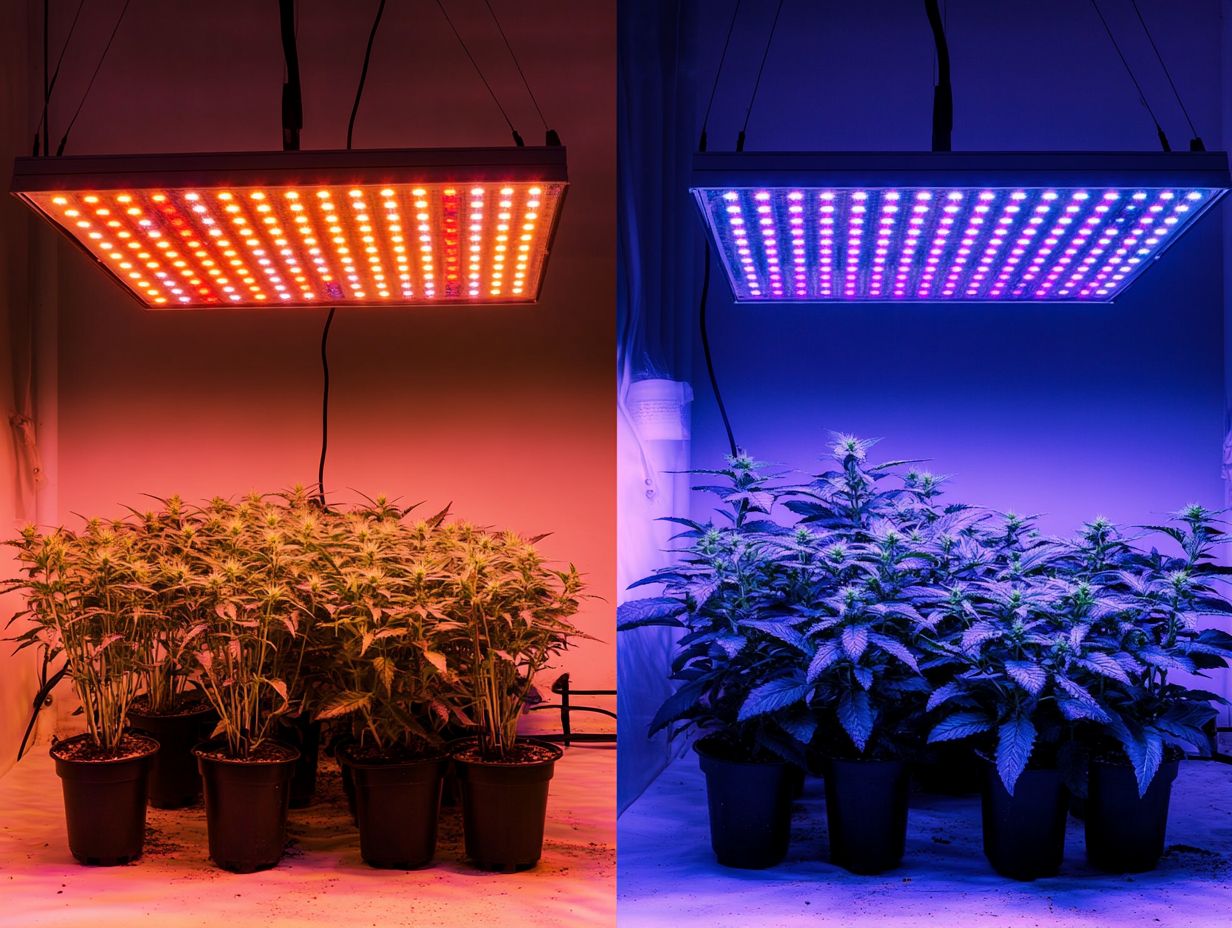
One of the standout features of LED grow lights is their incredible longevity and durability, often lasting up to 50,000 hours or even more. This remarkable lifespan significantly cuts down on maintenance costs for you as an indoor grower.
In comparison to traditional fluorescent lamps, which typically last around 10,000 hours, LEDs offer a level of convenience that gardening enthusiasts truly appreciate. Since LEDs are solid-state (which means they have no fragile parts), they are less likely to break than those fragile fluorescent tubes. Factors like heat dissipation and energy efficiency also play a role in extending their operational life.
This impressive longevity provides consistent light availability, which is important for helping your plants grow continuously. Ultimately, this enhances your gardening efficiency and boosts plant health over time.
Benefits of Fluorescent Grow Lights
Fluorescent lamps, such as the T5 and T8 varieties, stand out as a favored option for indoor gardening. Their lower upfront costs make them accessible, while their capacity to offer a broader light spectrum addresses the varied needs of plants throughout different growth stages.
This versatility ensures that your plants receive the optimal light conditions essential for thriving, particularly during the germination and flowering stages.
Lower Upfront Cost
One of the most attractive features of fluorescent lamps is their lower upfront cost, making them an ideal choice if you’re just starting with indoor gardening or working with a limited budget for your grow operation.
This affordability significantly lowers the barrier to entry, allowing you to experiment with indoor cultivation without a hefty financial commitment. However, while the initial investment may be minimal, it’s important to consider the hidden costs tied to energy consumption and routine maintenance. Over time, these factors can accumulate, potentially affecting the overall cost-effectiveness of fluorescent lamps.
As a new grower, you should carefully weigh these long-term expenses against the benefits of using this type of lighting, including lower energy consumption and maintenance. This ensures that you make a well-informed decision that aligns with your cultivation goals.
Wider Light Spectrum
Fluorescent lamps offer a broader light spectrum, which is especially advantageous for seedling growth and can elevate the overall photosynthesis process for various plants in indoor gardening. This rich array of wavelengths supports essential growth stages, including germination and flowering.
Take popular herbs like basil and parsley, for instance; they thrive brilliantly under this lighting as it mimics the natural daylight they love. Flowering plants, such as African violets, reveal their vibrant blooms when nurtured with fluorescent light, enhancing your indoor gardening endeavors.
By incorporating these lamps, you can effectively simulate different light conditions, fostering robust root systems and lush foliage. This ultimately leads to stronger and more productive plants, bringing your indoor garden to life.
Ready to revolutionize your indoor gardening? Make the switch to energy-efficient LED grow lights today!
Comparison of LED and Fluorescent Grow Lights
When you compare LED grow lights to fluorescent lamps, it s essential to delve into their key differences in performance and features, particularly regarding energy efficiency and light spectrum.
Each technology offers distinct advantages that cater to specific gardening needs, including light control and energy efficiency. This allows you to make an informed choice that best supports your growth objectives.
Key Differences in Performance and Features
You ll notice key differences in performance when comparing LED grow lights to fluorescent lamps, particularly in light intensity and energy efficiency. Understanding these factors is crucial, whether you are just starting out or you have been growing for years and want to optimize your setup.
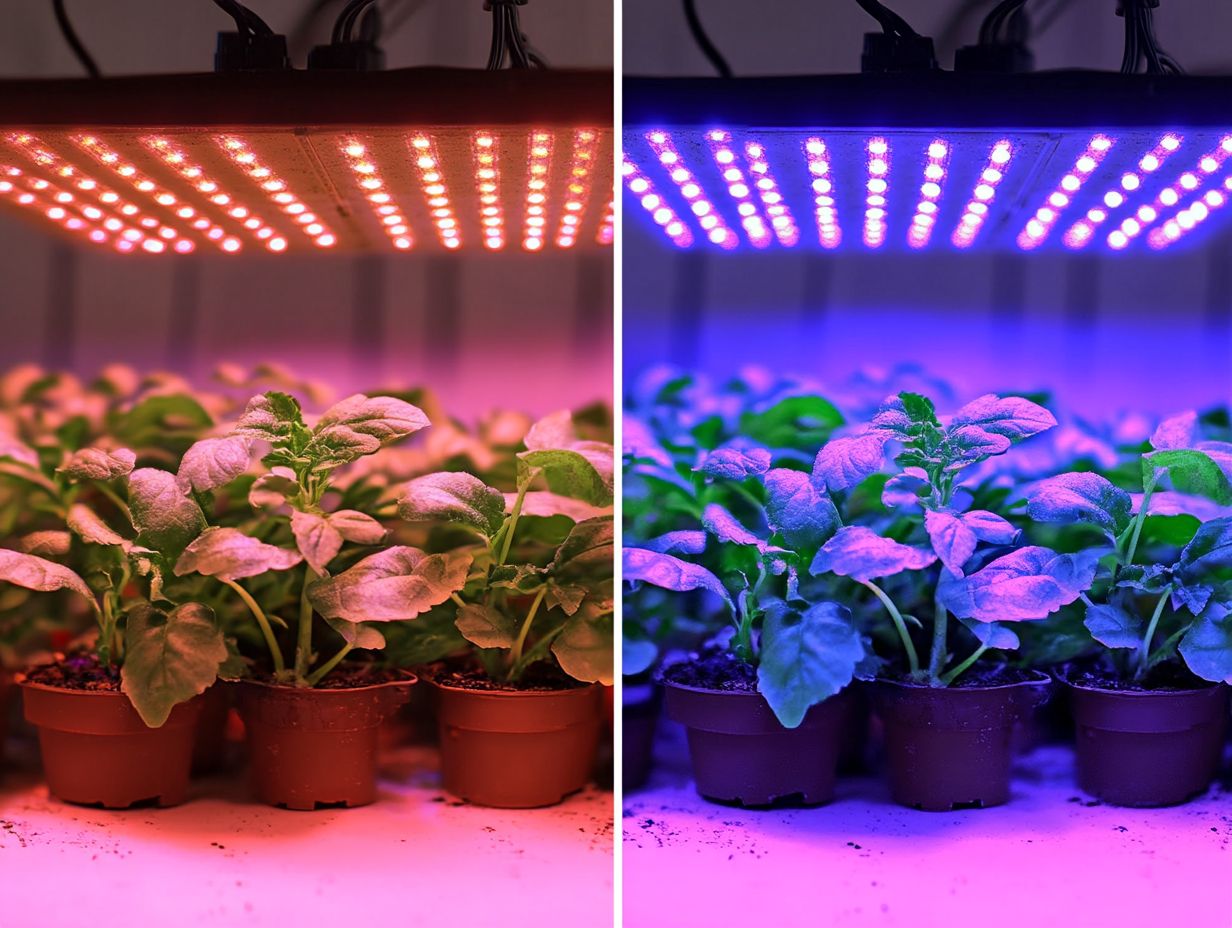
For example, LED grow lights are renowned for their superior light output and lower heat emission. You can position LED lights closer to your plants without risking burns. This is especially beneficial during the critical seedling stage.
On the other hand, fluorescent lamps may struggle with light intensity, which can hinder effective photosynthesis the process by which plants make food from light during those essential growth periods.
Energy consumption is another significant factor. While LEDs might require a larger initial investment, their long-term efficiency can lead to noticeably lower electricity bills. This positively influences the flowering stage and overall plant health.
Choosing the Right Grow Light for Your Needs
Selecting the ideal grow light for your needs requires you to think carefully about various exciting factors. You ll want to consider the types of plants you re cultivating, your budget constraints, and the specific requirements for your indoor gardening setup.
Each element plays a crucial role in ensuring your plants thrive under the right conditions.
Factors to Consider
When selecting the ideal grow light, you’ll want to consider several key factors, such as light intensity, energy efficiency, environmental impact, and the specific requirements for plant growth in your indoor gardening setup.
Evaluating the light spectrum is essential; different plants thrive under particular wavelengths. For example, blue light is excellent for promoting vegetative growth, while red light is crucial during the flowering stages.
Heat output is another critical element to factor in. Some grow lights can generate substantial heat, which may require you to implement additional cooling systems to maintain optimal temperatures for your plants.
Beyond these technical specifications, it’s vital to understand the potential toxic waste associated with certain light types. This knowledge allows you to align your choice of grow light with your gardening goals, ensuring that you prioritize both plant health and sustainability.
Frequently Asked Questions
What is the difference between LED and fluorescent grow lights?
LED grow lights use light-emitting diodes to produce light, while fluorescent grow lights use a gas-filled tube to produce light.
How do LED and fluorescent grow lights compare in energy efficiency and lifespan?
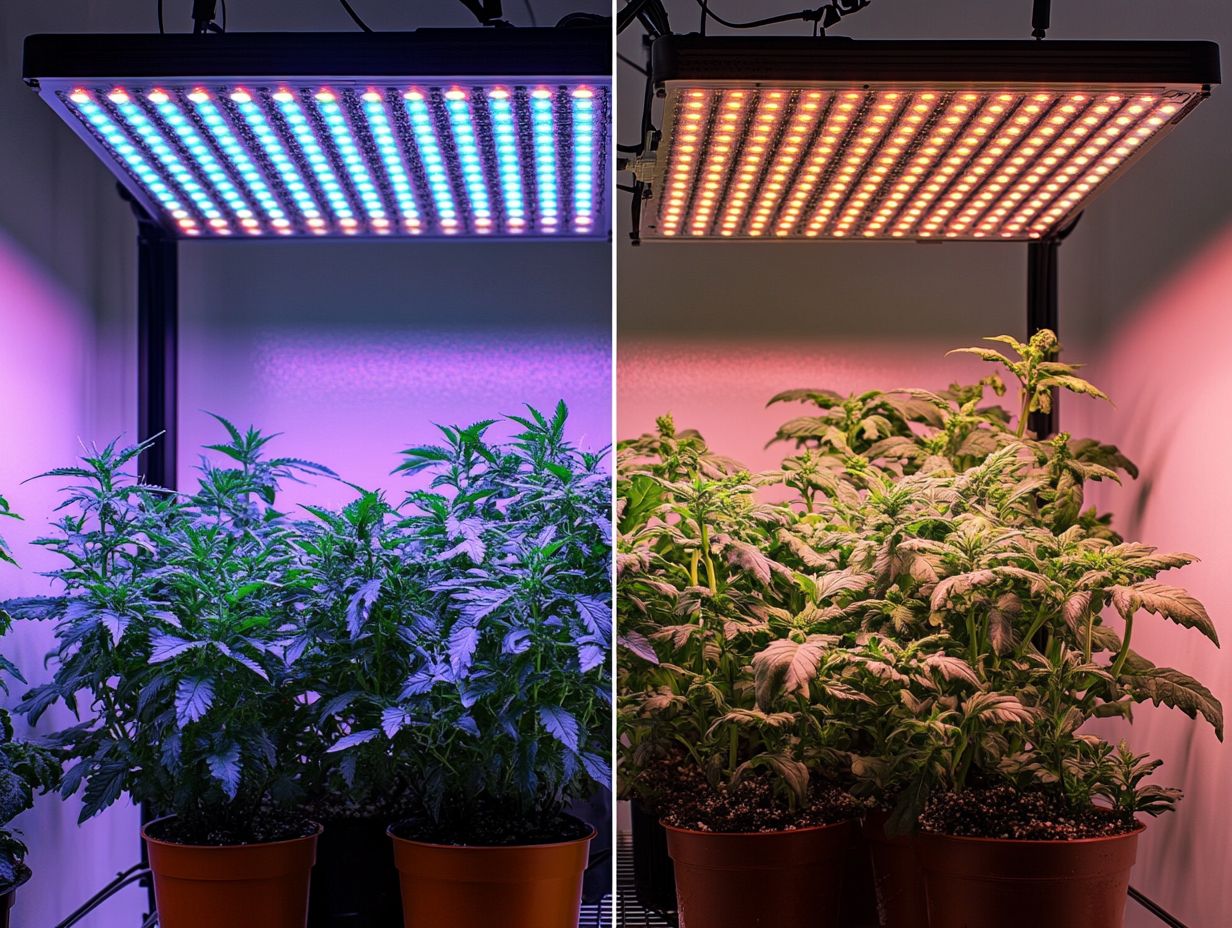
LED grow lights are more energy-efficient than fluorescent grow lights. They consume less power and produce more light, making them a more cost-effective option in the long run. Additionally, LED grow lights have a longer lifespan, lasting up to 50,000 hours, while fluorescent grow lights typically last around 10,000 hours.
Do LED and fluorescent grow lights require different maintenance?
Yes, they do. LED grow lights have a longer lifespan and do not require frequent bulb replacements like fluorescent grow lights. However, both types of lights require regular cleaning and proper ventilation for optimal performance.
Which Type of Grow Light is Best for Indoor Gardening?
LED grow lights stand out for indoor gardening. They are energy-efficient, last longer, and can produce specific colors of light that help plants grow at different stages.
Fluorescent grow lights are also a good choice. They can meet the specific needs of your plants, depending on what you re growing.

